In Sebastopol, the UC Master Gardeners of Sonoma County have refurbished an area near the front of the Sebastopol Center for the Arts on High Street. Visitors to SebARTS may find inspiration for their own gardens in this Demonstration Garden outside before heading inside to find inspiration from the art.
A Demonstration Garden with California Native Plants
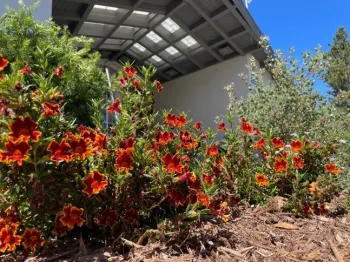
This garden at the entrance to the Sebastopol Center for the Arts (SebArts) provides beautiful plant ideas for home gardeners. The plants in this garden are reliable, hardy, mostly native to California, and water-wise.
Plants in the SebArts Demo Garden are identified with their botanical names for sharing with garden visitors.
Plants are arranged in a simple design for placement of shade plants and sun-loving plants. The aim is for something to be blooming, showing off foliage or structure during every part of the year.
Fire-wise landscaping practices were considered in plant selection and placement.
Plants have also been selected to build on those existing in the garden or originally planted by Habitat Corridor .
The mostly native plants in the garden support insects, birds and other pollinators.
Hopefully, this garden will inspire visitors to include some of these plants for their home gardens in Sebastopol or around Sonoma County.
Resilient Landscape and Sustainable Gardening Practices
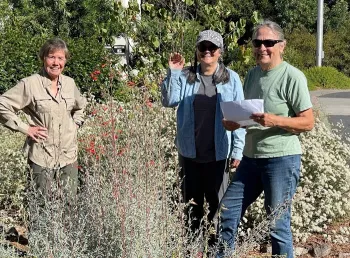
If you see Master Gardeners (MGs) pruning, planting and caring for the SebARTs garden, please feel free to ask your gardening questions. MGs are trained to share science-based sustainable gardening practices and emphasize garden resilience in this time of change. MGs may also be available during some SebArts events and succulent sales. MGs love to talk about plants, fire-wise practices, healthy soil, water-wise practices, sustainability, and more.
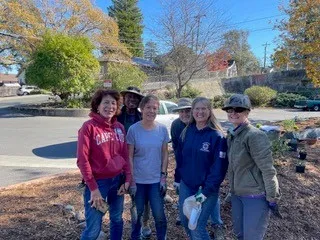
Creating the SebArts Demonstration Garden
In 2022, MGs were asked to adopt this garden space and revitalize it. We saw this as an opportunity to inspire home gardeners to select plants with sustainability in mind. The main objective was to showcase mostly native, fire-wise and water-wise plants suitable for the home garden.
Everything that grows in the SebArts garden can grow in a home garden with little water and can be planted in a fire-wise manner.
Controlling Weeds and Nurturing the Soil
Step 1: Weed Removal
First, the weeds and old plants were cleared and only a few structural native plants remained in the garden. These mature native plants served as visual anchors or foundations for new plantings. The generous team at Landcare donated labor to prepare the first areas of our garden.
Step 2: Sheet Mulch
Next, the area was ’sheet-mulched.’ This is a sustainable garden practice that lays overlapping sheets of compostable cardboard rather than a plastic weed barrier or toxic herbicides.
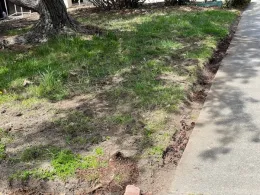
After removing weeds and dead or dying plants, a small 4-inch deep and 6” wide trench was dug around the perimeter of the garden. This trench prevents mulch from spilling onto the sidewalk.
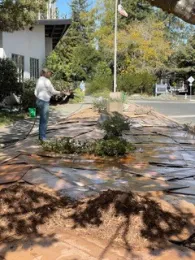
Step 3: Irrigation Installation
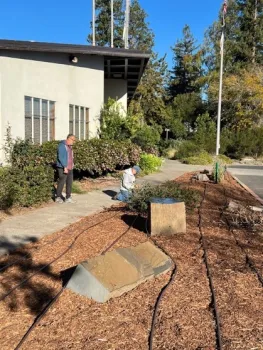
After sheet-mulching, an efficient and water-wise automatic irrigation system was installed. Irrigation installation is usually done after sheet mulching but before planting. Irrigation was tailored to specific plants which were placed together in the garden according to their water needs. These ‘hydro-zones’ allow for the most prudent use of water, a precious resource.
Step 4: Plant Shopping
With the garden cleared, mulched and irrigation installed, we were able to create our garden design plan. It was finally time for a trip to a native plant nursery to select more of the right plants to place in the right places in the garden.
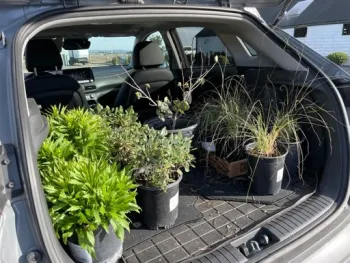
A Growing Garden at SebArtS
The SebArtS Demo Garden continues to evolve. We replace or relocate plants as needed, and have added new areas to our garden. The garden now includes a small area adjacent to the ceramics studio where picnic table seating was added and an art structure was installed to showcase ceramic works created by artists at SebArts. The newest area is an area to the right of the main entrance.
As outlined above, for each new area added, a sustainable garden plan is developed. Then it starts again: the new area is cleared of unwanted plants and weeds, followed by sheet mulching, irrigation installation and finally (usually in the fall when it’s best to plant native plants) it’s time to plant!
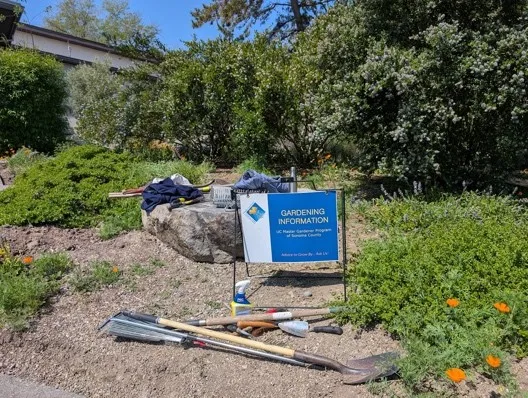
An Invitation to visit the SebArtS Garden
If you are a home gardener in Sonoma County, visit the SebArts garden any time to learn about the plants and check for local pollinators throughout the seasons.
Visit the pages on our UC Master Gardeners of Sonoma County website for more information on all aspects on home gardening. Find the projects that we support throughout the county as well as our upcoming lectures and events covering various gardening topics. Our Sonoma County UC Master Gardeners also have a robust social media presence. For seasonal garden tips, YouTube videos about sustainable gardening and more, click here for our social media information.
May 2025


